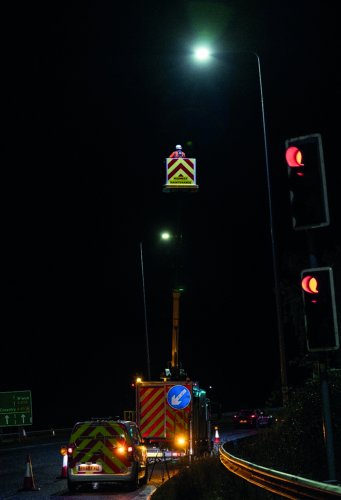New research has been carried out which will shed some light on how street lighting could be used to pave the way for autonomous vehicles in the future. Closed circuit television and wireless technology that enables vehicles to communicate is among the kit that could be neatly stored inside the lanterns of street lights alongside the National Highways network, the organisation says.
This could enable the existing infrastructure to be employed in the future to provide information on traffic updates, speed limits and diversions – helping vehicles to plan journeys more effectively.
Street lighting has often been viewed as a standalone asset but technology that has emerged in recent years could enable wider use of this vital infrastructure. Bandwidth has restricted air wave transmissions in the past, but with the roll-out of 5G and the IoT (Internet of Things) infrastructures, lighting could be equipped with devices such as wireless access points and cameras.
A ‘proof of concept’ trial of ‘intelligent’ street lighting has been carried out on the M40 at the junction 15 Longbridge roundabout near Birmingham. The CCTV and communications technology hidden in the street lamps was installed when the lights were switched to LED lighting, and the Illuminate trial took place over five months last year. It was said to have successfully proved the concept, with the technology able to communicate data to office equipment and tablet computers.
National Highways said that the knowledge gained in the trial will be used to help shape its strategy for managing the Connected and Autonomous (CAV) infrastructure. The organisation is looking for technologies that can effectively support autonomous vehicles so they can push and receive messages across the network. These messages could include speed limits, incidents, updates on clearance times, to provide useful information to help drivers plan their journeys.
This would involve a large-scale deployment of technology across the network and street lights may be the answer, National Highways believes. National Highways’ Innovations Lead for the Midlands Lisa Maric said: “These are exciting times as we progress on our Digital Roads journey with the growth of digital technology and the move to electric, connected and autonomous vehicles that will fundamentally change how we use roads in the future.
“National Highways is committed to ensuring we are at the forefront of this digital revolution and are preparing the way for the greener and safer roads of tomorrow.”
The trial has been funded through National Highways’ Innovation and Modernisation Fund which is helping to maximise the opportunities offered by developments such as automated vehicles while putting safety at the forefront of emerging technologies.


